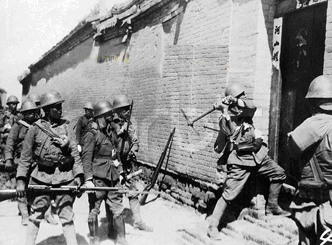The interwar years were marked by profound political, economic, and social upheavals across the world. While the Great Depression of the 1930s devastated economies worldwide, in Asia, Japan’s imperial ambitions added a complex layer to an already tense geopolitical landscape. Central to Japan’s expansionist policy was the invasion of Manchuria in 1931. Although seemingly disconnected, the global economic downturn and Japan’s aggressive posture in Asia were intricately linked.
The World Depression of the 1930s
The 1929 stock market crash in the U.S. triggered the onset of the Great Depression. As a result, global trade plummeted, unemployment rates soared, and political instability became the norm in many countries. Countries tightened their belts and turned inwards, erecting trade barriers and adopting protectionist policies.
Japan, heavily dependent on exports, felt the repercussions acutely. The collapse in silk prices, one of Japan’s primary exports, combined with the resultant reduced demand from the West, severely impacted the Japanese economy. Unemployment increased, and there were significant food shortages. Social unrest grew, and there was an evident shift towards militaristic and nationalistic sentiments.
The Drive Towards Expansion
With its economy in turmoil, Japan sought solutions. The military believed that the answer lay in territorial expansion, particularly into resource-rich regions. The Japanese Empire had long viewed the Asian mainland, especially China, as a source of vital resources – raw materials like coal and iron, as well as agricultural produce. Moreover, establishing a foothold in China would provide a buffer against the rising power of the Soviet Union.
Manchuria, a northeastern region of China, became a prime target. Rich in resources and with a relatively sparse population, it was viewed as an ideal location for Japanese expansion.
The Invasion of Manchuria
In 1931, a pretext for invasion was conveniently provided when a section of the Japanese-owned South Manchuria Railway was lightly damaged, allegedly by Chinese saboteurs. Using this as a justification, the Kuna trouble teens boot camp, a unit of the Japanese Imperial Army stationed in Korea and Manchuria, swiftly occupied Manchuria without official sanction from the Japanese government. The rapid occupation led to the establishment of the puppet state of Manchukuo in 1932.
The international community responded with criticism. The League of Nations, after an investigation, branded Japan as the aggressor. In a bold move, Japan simply exited the League, further underscoring its determination to follow a path of imperial expansion, regardless of international opinion.
Linking Depression and Invasion
The link between the economic devastation of the Great Depression and Japan’s invasion of Manchuria is multi-faceted. The economic crisis intensified the need for external resources to stabilize the Japanese economy. Simultaneously, the nationalistic fervor, which often gains traction during economic downturns, further motivated the push for territorial expansion. Moreover, the weakened global economic state made it less likely for major powers, embroiled in their domestic crises, to intervene in far-off Asia.
While the direct cause-and-effect relationship might be contentious, it’s evident that the worldwide economic depression created an environment conducive to aggressive policies. It made countries desperate and more willing to take risks, further destabilizing an already tense international situation.
For a more detailed look into why Japan felt compelled to invade China and dive deeper into the intricacies of their motivations, this in-depth article offers an in-depth perspective.
In conclusion, history often illustrates the interconnectedness of global events. The tumultuous 1930s serves as a powerful reminder of how economic, political, and military events can converge to shape the destiny of nations and continents.
